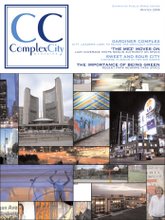Sky park
 BY SEAN PEARCE
BY SEAN PEARCE
In the depths of the urban jungle it can be difficult to find a tranquil piece of green space amid the sprawl sometimes, but at one downtown location nature abounds. In the spring and summer green plants flourish, flowers blossom and weary urbanites happily eat their lunches on wooden picnic tables free from the hustle and bustle below. Welcome to 401 Richmond’s rooftop garden.
Erin MacKeen, communications representative for 401 Richmond Ltd., says that her building’s green roof has been a great attraction for both tenants and the community.
“401 Richmond’s green roof is open to the public during business hours,” MacKeen said. “It’s used primarily by tenants, but people in the surrounding neighbourhood also go up there to eat lunch and congregate.”
MacKeen said that many of the businesses housed within 401 Richmond use the green roof for events also.
“Some of our tenants hold meetings and special functions up there,” she said. “And it’s not just great in terms of a public space improvement or as a place for people to meet, but there also a variety of environmental applications we support as well.”
The green roof located at 401 Richmond could only be the beginning of a new trend. Steven Peck is the founder and president of Green Roofs for Healthy Cities, an organization committed to advancing green roof programs around the world. Peck believes that green roofs enhance the quality of life for urban dwellers.
“There’s a lot of opportunity to generate a higher quality of life in Toronto by using roof space as both publicly accessible and privately accessible recreational space,” Peck said.
Peck explains that not all green roofs need to be accessible either. Those that are inaccessible can be host to wildlife and just help to add some colourful contrast.
“There can be green roofs that are not accessible, but provide a lot of amenity value for those looking down upon them,” he said. “There are different dimensions to this thing in terms of the values; there’s an aesthetic dimension and an accessibility dimension.”
One of the numerous other buildings around the city now sporting the green roof look is Jackman Avenue Public School. The school’s principal, Terry Walsh, says although the rooftop is inaccessible it’s still a popular sight for students, staff and parents.
“(The green roof) was something championed by a community group of parents and the kids, too,” Walsh said. “It was nothing, but a black asphalt roof before.”
Walsh says that in general people really enjoy being able to look down from the third floor of the school and see a lush carpet of green.
Still, Toronto’s experience with green roofs is in its infancy. Some green roofs in other cities are already host to a whole assortment of different activities. Chicago’s award-winning Millennium Park, which sits atop an underground parking garage, boasts acres of trees, trails and numerous cultural attractions. Peck says the possibilities are endless.
“We’ve got green roofs that are everything from lawn bowling fields to product showrooms,” Peck said. “There’s a huge spectrum out there and so there’s a great opportunity to intensify (green roofs) in Toronto.”
Despite the benefits, Toronto has a long way to go before it sees a Millennium Park of its own.
Jane Welsh, project manager in the city planning department, identified some important obstacles to be overcome before sky-high parks become feasible.
“Toronto’s parks and recreation department doesn’t want to take them on as park land when they’re up in the air like on top of a building and the reason is many are not publicly accessible,” Welsh said.
Welsh cited another problem, there is seldom enough growing medium to allow for tree growth. Toronto has, however, been very encouraging of green roofs, because they still enhance the public space in visible ways.
“If you think of a park as an opportunity for a view of green then it’s wide open, because everyone in surrounding buildings can see it,” she said. “In other word’s it’s a chance to see a park in the sky.”
Even if it isn’t exactly possible to play softball on the top of a high-rise just yet Welsh doesn’t rule out anything in the future.
Peck likes what he sees, so far, but he is also looking ahead to the future.
“Green space becomes a real premium as more people live in the city,” Peck says. “Why not have a plan to create the equivalent of a High Park on the roofs of the city over the next 10 to 15 years?”





No comments:
Post a Comment